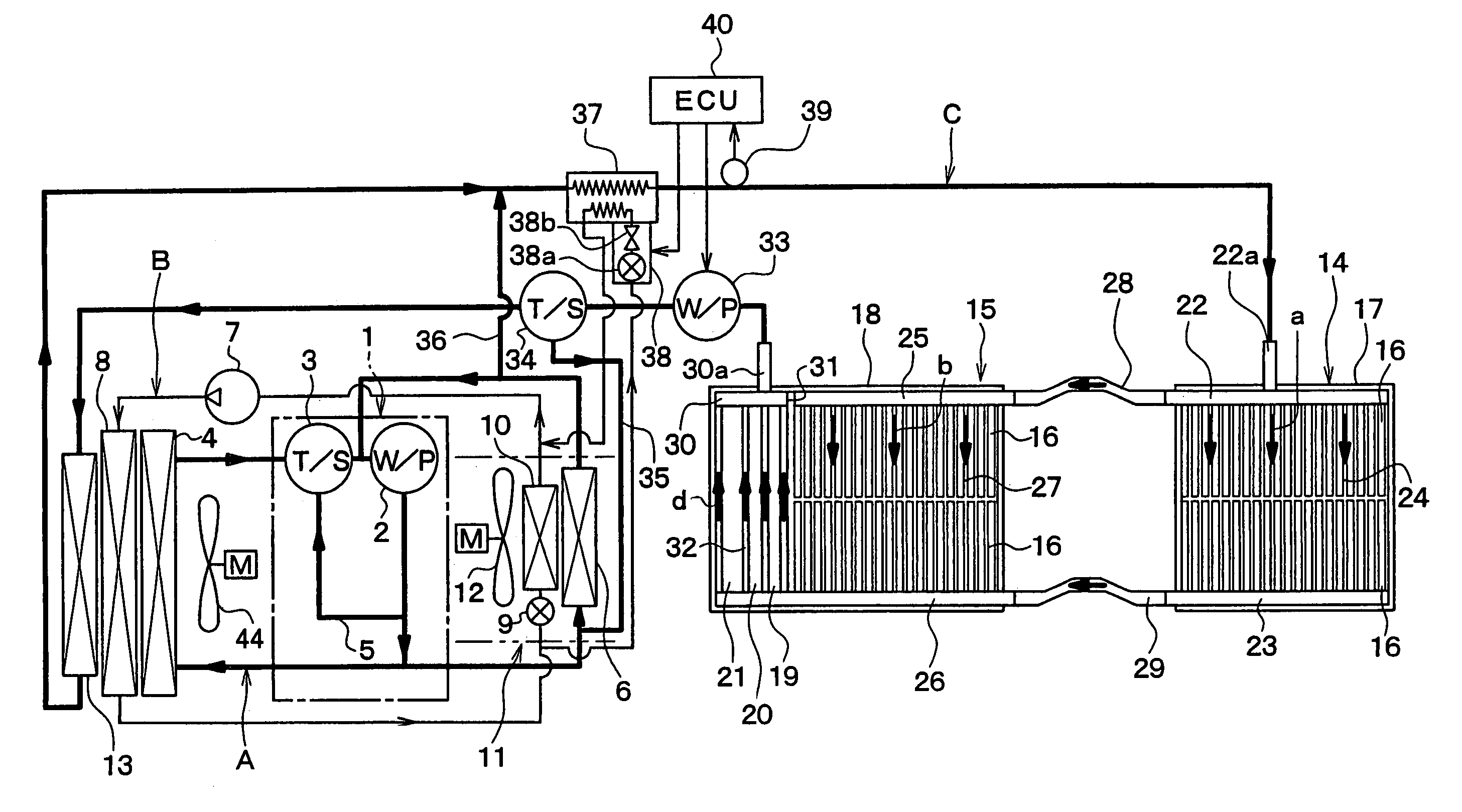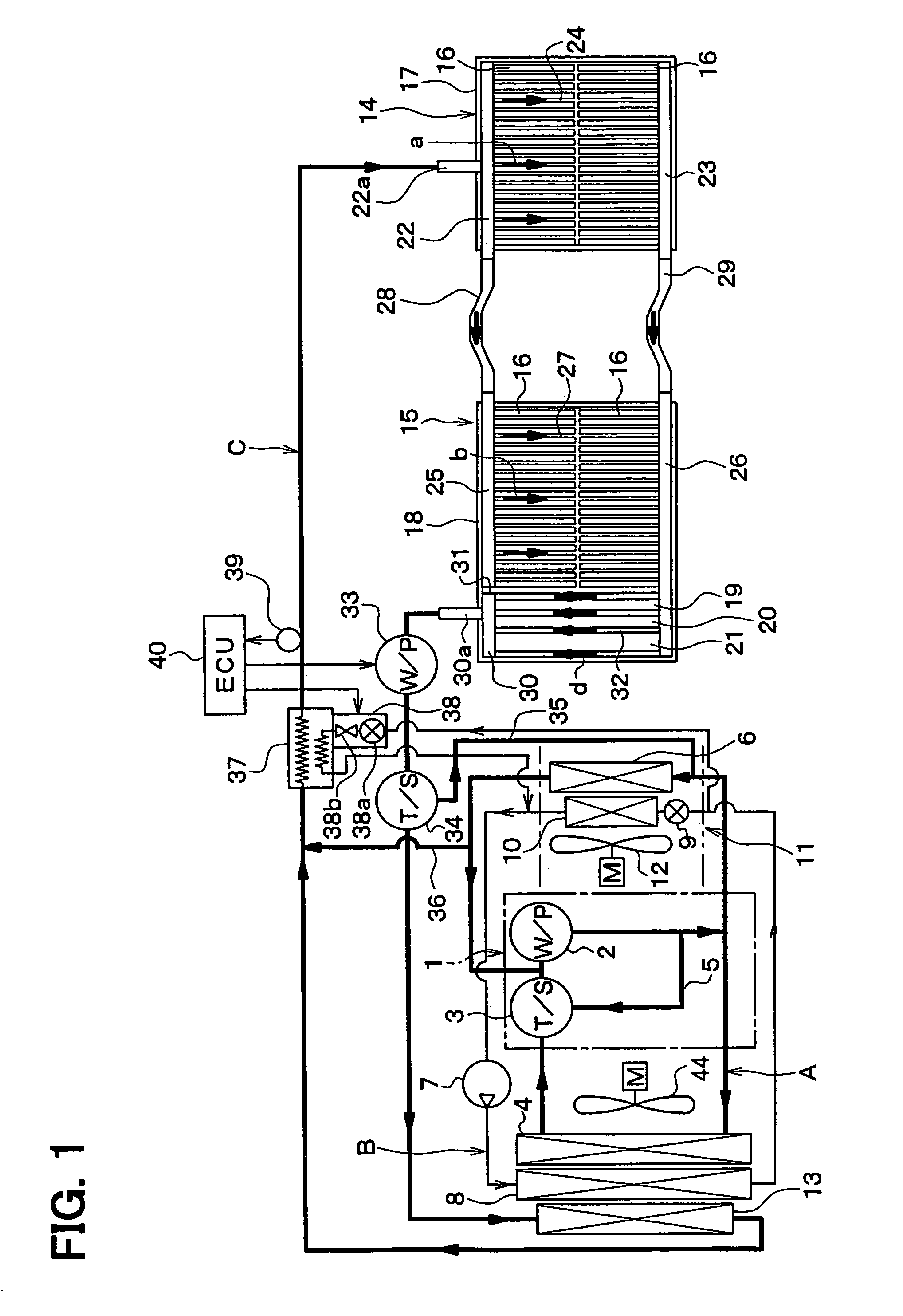Cooling structure of heat generating member
a technology of heat generating member and cooling structure, which is applied in the control arrangement of battery/fuel cell, electric devices, electrochemical generators, etc., can solve the problem of increasing the size of the battery system
- Summary
- Abstract
- Description
- Claims
- Application Information
AI Technical Summary
Benefits of technology
Problems solved by technology
Method used
Image
Examples
first embodiment
[0037]FIG. 1 shows a schematic diagram showing an entire system of the first embodiment. In this embodiment, the present invention is typically applied to a hybrid vehicle which is driven by an engine (internal combustion engine) 1 and an electrical motor (not shown) as driving sources.
[0038]The system of the first embodiment is constructed with a cooling water circuit A of an engine 1, a refrigerant cycle B for a vehicle air conditioner, a cooling water circuit C for heat generating members.
[0039]The cooling water circuit A of the engine 1 has a structure generally known. A water pump 2 driven and rotated by the engine 1 is located in the cooling water circuit A so as to circulate cooling water in the cooling water circuit A by the operation of the water pump 2.
[0040]A thermostat 3 is arranged at a suction side of the water pump 2, and is used as a thermal responding valve operated in accordance with a cooling water temperature. A radiator 4 and a bypass passage 5 are arranged in p...
second embodiment
[0095]The second embodiment of the present invention will be now described with reference to FIG. 4. In the second embodiment, a spring member 61 is located inside the case 18 so as to accurately press-contact each of the heat generating members (e.g., battery parts 16, DC voltage converters 19, 20, electrical member 21) and the heat exchanging plate member 51, 52. The cooling structure of the second embodiment is described by using the second cooling unit 15 described in the first embodiment. Furthermore, the parts of the second cooling unit 15 of FIG. 4, similar to those of the first embodiment, are indicated as the same reference numbers, and detail description thereof is omitted.
[0096]The spring member 61 is formed from a metal spring material, and is formed into a plate shape. As shown in FIG. 4, the spring member 61 is located between an inner wall surface of one end of the case 18 and one end portion of the heat exchanging plate members 51, 52 in the laminating direction. In ...
third embodiment
[0100]FIG. 5 shows the third embodiment that is a modification of the above-described second embodiment. In the third embodiment, the DC voltage converters 19, 20 are arranged in parallel on the side of the outlet passage portion 30 partitioned from the inlet passage portion 25, so that each of the DC voltage converters 19, 20 is cooled from both sides. In contrast, the electrical member 21 of the second embodiment is provided outside of the case 18. In the third embodiment, the other parts can be made similar to those of the above-described second embodiment.
PUM
| Property | Measurement | Unit |
|---|---|---|
| temperature | aaaaa | aaaaa |
| voltage | aaaaa | aaaaa |
| DC voltage | aaaaa | aaaaa |
Abstract
Description
Claims
Application Information
 Login to View More
Login to View More - R&D
- Intellectual Property
- Life Sciences
- Materials
- Tech Scout
- Unparalleled Data Quality
- Higher Quality Content
- 60% Fewer Hallucinations
Browse by: Latest US Patents, China's latest patents, Technical Efficacy Thesaurus, Application Domain, Technology Topic, Popular Technical Reports.
© 2025 PatSnap. All rights reserved.Legal|Privacy policy|Modern Slavery Act Transparency Statement|Sitemap|About US| Contact US: help@patsnap.com



